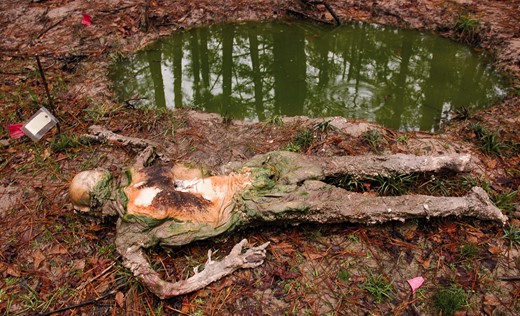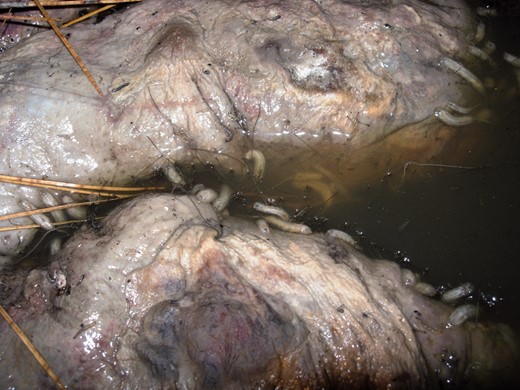

Description:
Cadaver STAFS2009-003 was a 76-yr-old male who died of natural causes. This person died on 30 January 2009 and spent approximately 111 d in coolers before placement outdoors in an area of partially filtered sunlight for study on 21 May 2009 at 1400 hours. This body was nonautopsied, unclothed, and placed facing down in a grave under approximately 60 cm of soil near an ephemeral stream. This cadaver remained buried until 17 September 2009 when the soil covering the grave was purposefully removed using a backhoe and shovels and completely exposed the head, buttocks, and one arm and hand. The exposed skin on the cadaver appeared leathery. The cadaver remained exposed within the grave, which filled and drained repeatedly with rain water. Oviposition by adult Eristalis arbustorum (L. 1758) was observed on the edges of the gravesite from 30 September through 5 October 2009; the temperature for these days ranged from 13–31°C, averaging 22°C, with ∼11.5 mm of rainfall. Larvae of this species, along with other species that have similar morphology, are colloquially known as rattail maggots.
On 8 October 2009, the cadaver was completely exhumed using shovels from the soil and bricks were placed underneath the body in an attempt to raise the cadaver above the water level of the grave. The presence of adipocere was noted around the buttocks, thigh, and calf areas of the cadaver. Rainwater, again, repeatedly filled the shallow grave and most of the cadaver was submerged occasionally, leaving only the middle of the back exposed to the air. Rattail maggots were observed on the cadaver, which was partially submerged in water, from 10–29 November 2009; the temperature for these days ranged from 1–26°C, averaging 14°C, with ∼48 mm of rainfall. Larvae were collected from the cadaver for the purpose of rearing and identification, but did not reach pupation. It is reasonable to conclude that the rattailed maggots associated with this cadaver were offspring of the adult females that were collected during oviposition. During the course of this yearlong survey, these were the only syrphid species observed or collected. The larvae were noted moving their anterior end up and down across the flesh and entering in and out of small tunnels within the flesh. On 2 February 2010, the cadaver was fully removed from the shallow grave and placed atop the ground next to the water-filled shallow grave. Hundreds of dead rattail maggots were observed intertwined within the previously submerged adipocere on the underarms, buttocks, thighs, and calves of the cadaver. The temperatures from 29th of November 2009 through 2 February 2010 ranged from −10–25°C, averaging 8°C, with ∼40 mm of rainfall. It is possible that the below freezing temperatures that occurred after the 29th of November could have killed the rattail maggots. After being unearthed, this cadaver did not attract many insects besides the Syrphidae and was never colonized by Calliphoridae or Sarcophagidae. Adult Prochyliza xanthostoma Walker 1849 were collected from the cadaver throughout the course of this study. Culicidae larvae were collected from the water surrounding the cadaver. Psycodidae were also collected from this cadaver with a detailed description of that event presented in the next section.
Previous accounts of Syrphidae colonizing carrion and human corpses are sparse, albeit this genus (Scott 1964, Aguilera et al. 1999, Salimi et al. 2010) and species (James 1947) has been reported to cause myiasis in humans. Osten-Sacken (1894) dispelled the myth of the spontaneous generation of bees from dead ox by correlating the visual similarities between Eristalis tenax (L. 1758) and honey bees in conjunction with the wet-carrion feeding life histories of rattail maggots. The larvae of E. tenax can be found in sewage, liquid excrement, decaying carcasses, and other foul organic matter (James 1947).
Archer and Ranson (2005) report that rattail maggots in Victoria, Australia, are sometimes associated with decomposing bodies found partially submerged in freshwater and that this insect is not expected from fresh, dry bodies found indoors. Martins et al. (2010) documents the colonization of pig carrion in Brazil by Ornidia obesa F. 1775, which is in the same subfamily as Eristalis (Eristalinae). Martins noted that these syrphid larvae buried themselves into the flesh in a manner similar to that of sarcophagid larvae. The pig that reached the drier stage of decay more quickly did not have post feeding larvae present whereas the pig that remained wetter and decayed more slowly had post feeding larvae present. In Italy, Syritta pipiens (L. 1758) were found on a body in a well and on a partially buried body both having formed adipocere (Magni et al. 2013a,b).
To our knowledge, this is the first record of E. arbustorum colonizing a human cadaver. The circumstances surrounding this occurrence draw parallels with previous records of related flies in that the breeding site must be wet and foul and that the larvae burrow into the flesh. E. arbustorum and other syrphids with similar life histories could be useful in forensic entomology situations. It is possible that E. arbustorum can colonize a cadaver in a predictable manner under conditions favorable to its development similar to how Calliphoridae predictably colonize exposed terrestrial carrion. If this were the case, colonization by Eristalis sp. could then be used to assist in PIA estimation. E. arbustorum is distributed throughout Europe, North America, North Africa, Asia Minor, and Siberia (Telford 1970).
Gallery
| Species | Taxonomy | Accession Number |
|---|---|---|
| Eristalis tenax |
Reference:
1.Natalie K. Lindgren, Melissa S. Sisson, Alan D. Archambeault, Brent C. Rahlwes, James R. Willett, Sibyl R. Bucheli, Four Forensic Entomology Case Studies: Records and Behavioral Observations on Seldom Reported Cadaver Fauna With Notes on Relevant Previous Occurrences and Ecology, Journal of Medical Entomology, Volume 52, Issue 2, March 2015, Pages 143–150, https://doi.org/10.1093/jme/tju023
 HOFE
HOFE